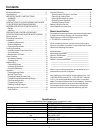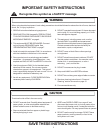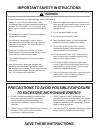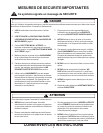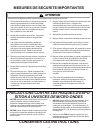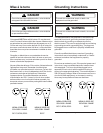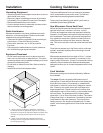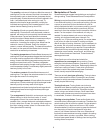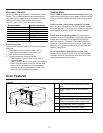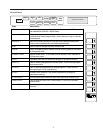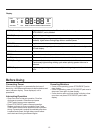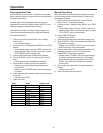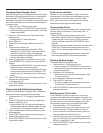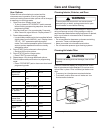
9
The quantity or volume of a food can affect the amount of
cooking time. As the volume of the food is increased, the
time required to cook or heat the item increases almost
proportionately. If twice the amount of food is placed in the
oven, it will take almost twice as long to cook. To
determine the time for larger quantities, multiply the
individual serving time by the increased amount - then
reduce the total heating time by about 20%.
The density of foods can greatly affect the amount of
cooking time. Porous foods, such as breads, cakes or
pastries, will heat much more quickly than dense meats
of the same size. Porous foods absorb microwaves
quickly throughout. Meats absorb microwaves mostly at
the exterior surface, and the interior is heated by
conduction, increasing the cooking time. Meats can be
cooked in a sauce, if desired. Due to the moisture
content, a sauce will heat rapidly. The heat will transfer to
the meat, so the meat will heat faster due to heat by
conduction as well as by microwaves.
The starting temperature of foods affects the amount of
cooking time. Each temperature degree that the food item
is to raise must be supplied with a definite amount of
energy. Lower initial starting temperatures require more
energy and more time to cook. Therefore, refrigerator
temperature foods require a longer cooking time than do
room temperature foods. Foods already slightly warm will
heat very quickly in the Oven.
The moisture content of foods affects the amount of
cooking time. The higher the moisture content is in a food
the longer the amount of cooking time.
The fat and sugar content of foods affects the amount of
cooking time. Foods containing high fat and sugar levels
heat very quickly and may reach much higher
temperatures than foods having low fat and sugar levels.
Foods having lower fat and sugar levels require longer
cooking times.
The arrangement of food within a microwave oven cavity
affects the way in which the food cooks. A round
arrangement is best. Use round utensils whenever
possible. Also, arrange foods such as baked potatoes in
a circle, rather than in rows, for cooking. When only one
food item is being cooked, place it in the center of the
Oven glass shelf for cooking.
Manipulation of Foods
Sometimes recipes suggest manipulating or moving food
during cooking. There are several forms of manipulation:
Stirring is required less often in microwave cooking than
in conventional cooking. In conventional cooking, you use
a spoon to move food up from the bottom of a pan to
evenly distribute the heat. In microwave cooking, you still
stir to redistribute the heat within some foods, but you
need to stir from the outside of a dish toward the inside or
center. For the recipes in this cookbook, stir only as
needed. If a recipe states to stir once or twice during
cooking, stir at approximately even intervals. For
example, in a 12-minute cooking period, if a recipe states
to stir twice, stir after 4 minutes of cooking and again,
after 8 minutes of cooking. However, it is not necessary to
be precise. Stir only when necessary. When using lower
power settings, less stirring is required. Some examples
of foods which may require stirring are puddings, some
casseroles, some sauces, some soups, and some egg
dishes. Some foods cant be stirred. These foods are
rearranged or turned.
Some foods can not be stirred and should be
repositioned or rearranged during cooking. Some
examples include baked potatoes, cupcakes (in custard
cups), chicken pieces, and others. Rearranging allows for
more even cooking of foods. Foods which are cooked,
covered, or which are cooked using lower Cookmatic
Levels, usually require little rearranging.
There are actually two types of turning. Turning is done
when foods cannot be stirred. Foods which are cooked,
covered, or which are cooked at lower Cookmatic Levels
usually require little turning.
Turning foods over: Turning foods over is done to
distribute heat. Meat and poultry are two types of foods
which are sometimes turned over. Examples include
roasts, turkeys and whole chickens. Small meat items
such as poultry pieces may need to be turned over when
in casseroles, or when in a browning skillet.
Rotating or turning dishes: There are few foods which
cannot be stirred, rearranged or turned over. Therefore, the
actual cooking dish is turned or rotated. For the recipes in
this cookbook, turn a dish one-half-turn or 180° unless
otherwise stated. A half-turn means to grasp the dish and
turn the portion of the dish that faces the oven door
around, until it faces the back of the oven. Examples of
foods which are sometimes turned or rotated in a cooking
dish include cakes, quiches, or soufflés. When cooking
foods at lower power levels or Settings, less turning of the
cooking dishes is required.




